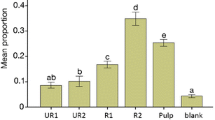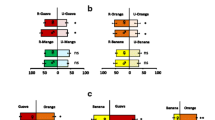Abstract
A new blend of volatiles was identified for the fruit of downy red hawthorn, Crataegus mollis, that is attractive to Rhagoletis pomonella flies infesting this host in the northeastern USA. The new blend was as attractive as the previously identified mixture but is more complex in the number of odorants (six in the old versus ten in the new) and differs significantly in the ratio of three volatiles, 3-methylbutan-1-ol, butyl hexanoate, and dihydro-β-ionone, that are common to both blends and exerted agonist or antagonist effects on behavior in a flight tunnel assay. However, behavioral results with the old and new northern hawthorn blends, as well as modified blends with substituted ratios of 3-methylbutan-1-ol, butyl hexanoate, dihydro-β-ionone, indicated that the ‘agonist’ or ‘antagonist’ effects of these volatiles depended on the ratio, or balance of compounds within the blend. In addition, the new blend contains a number of esters identified from the headspace of domesticated apple, Malus domestica, that are attractive to apple-origin R. pomonella, and present in the five other blends from southern hawthorns, including the southern C. mollis var. texana blend, but are not part of the previously identified blend from northern C. mollis fruit. This finding supports the hypothesis that in addition to providing specificity to the odor blends of the northern and southern hawthorn populations, the presence of the significant amounts of ester compounds in the new northern hawthorn blend might have provided a source of standing variation that could help explain the shift in host preference by C. mollis-infesting flies to introduced apple in the mid-1800’s.




Similar content being viewed by others
References
Agelopoulos NG, Pickett JA (1998) Headspace analysis in chemical ecology: effects of different sampling methods on ratios of volatile compounds present in headspace samples. J Chem Ecol 24:1161–1172
Baker TC (2008) Balanced olfactory antagonism as a concept for understanding revolutionary shifts in moth sex pheromone blends. J Chem Ecol 34:971–981
Bartelt RJ (1997) Calibration of a commercial solid-phase microextraction device for measuring headspace concentrations of organic volatile. Anal Chem 69:364–372
Bengtsson M, Bäckman A-C, Liblikas I, Ramirez MI, Borg-Karlson A-K, Ansebo L, Andersen P, Löfqvist J, Witzgall P (2001) Plant odor analysis of apple: antennal response of codling moth females to apple volatiles during phenological development. J Agric Food Chem 49:3736–3741
Berlocher SH, Enquist M (1993) Distribution and host plants of the apple maggot fly, Rhagoletis pomonella (Diptera: Tephritidae) in Texas. J Kansas Entomol Soc 66:145–166
Berlocher SH, Feder JL (2002) Sympatric speciation in phytophagous insects: moving beyond controversy? Annu Rev Entomol 47:773–815
Brown DS, Buchanan JR, Hicks JR (1966) Volatiles from apple fruits as related to variety, maturity and ripeness. P Am Soc Hortic Sci 24:2857–2859
Bush GL (1966) The taxonomy, cytology, and evolution of the genus Rhagoletis in North America (Diptera: Tephritidae). Bull Mus Comp Zool 134:431–562
Bush GL (1969) Sympatric host race formation and speciation in frugivorous flies of the genus Rhagoletis (Diptera: Tephritidae). Evolution 23:237–251
Bush GL, Feder JL, Berlocher SH, McPheron BA, Smith DC, Chilcote CA (1989) Sympatric origins of Rhagoletis pomonella. Nature 339(34):346
Carle SA, Averill AL, Rule GS, Reissig WH, Roelofs WL (1987) Variation in host fruit volatiles attractive to apple maggot fly, Rhagoletis pomonella. J Chem Ecol 13:795–805
Carson HL (1989) Sympatric pest. Nature 338:304
Cha DH, Powell THQ, Feder JL, Linn CE Jr (2011a) Identification of host fruit volatiles from Mayhaw (Crataegus series Aestivales) attractive to Mayhaw origin Rhagoletis pomonella flies. J Chem Ecol 37:961–973
Cha DH, Powell THQ, Feder JL, Linn CE Jr (2011b) Identification of host fruit volatiles from green hawthorn (Crataegus series Aestivales) and blueberry hawthorn attractive to southern Rhagoletis pomonella flies. J Chem Ecol 37:974–983
Cha DH, Nojima S, Hesler SP, Zhang A, Linn CE, Roelofs WL, Loeb GM (2008) Identification and field evaluation of grape shoot volatiles attractive to female grape berry moth (Paralobesia viteana). J Chem Ecol 34:1180–1189
Cha DH, Linn CE Jr, Teal PEA, Zhang A, Roelofs WL, Loeb GM (2011c) Eavesdropping on plant volatiles by a specialist moth: significance of ratio and concentration. PLoS One 6:e17033
Cha DH, Powell THQ, Feder JL, Linn CE Jr (2012a) Geographic variation in fruit volatiles emitted by the hawthorn Crataegus mollis and its consequences for host race formation in the apple maggot fly, Rhagoletis pomonella (Diptera: Tephritidae). Entomol Exp Appl 143:254–268
Cha DH, Yee W, Goughnour R, Sim SB, Feder JL, Linn CE Jr (2012b) Identification of host fruit volatiles from domesticated apple (Malus domestica), native black hawthorn (Crataegus douglasii) and introduced ornamental hawthorn (C. monogyna) attractive to Rhagoletis pomonella flies from the western United States. J Chem Ecol 38:319–329
Coyne JA, Orr HA (2004) Speciation. Sinauer Associates, Sunderland MA
Dambroski HR, Feder JL (2007) Host plant and latitude-related diapause variation in Rhagoletis pomonella: a test for multifaceted life history adaptation on different stages of diapause development. J Evol Biol 20:2101–2112
Egan SP, Ragland GJ, Assour L, Powell THQ, Hood GR, Emrich S, Nosil P, Feder JL (2015) Experimental evidence of genome-wide impact of ecological selection during early stages of speciation-with-gene-flow. Ecol Lett 18:817–825
Feder JL, Opp SB, Wlazlo B, Reynolds K, Go W, Spisak S (1994) Host fidelity is an effective premating barrier between sympatric races of the apple maggot fly. Proc Natl Acad Sci U S A 91:7990–7994
Fein BL, Reissig WH, Roelofs WL (1982) Identification of apple volatiles attractive to the apple maggot. J Chem Ecol 8:1473–1487
Forbes AA, Fisher J, Feder JL (2005) Habitat avoidance: overlooking an important aspect of host-specific mating and sympatric speciation? Evolution 59:1552–1559
Forbes AA, Feder JL (2006) Divergent preferences of Rhagoletis pomonella host races for olfactory and visual fruit cues. Entomol Exp Appl 119:121–127
Funk DJ, Filchak KE, Feder JL (2002) Herbivorous insects: model systems for the comparative study of speciation ecology. Genetica 116:251–267
Greenwald R, Chaykovsky M, Corey EJ (1963) The Wittig reaction using methylsulfinyl carbanion-dimethyl sulfoxide. J Org Chem 28:1128–1129
Linn CE Jr, Feder JL, Nojima S, Dambroski H, Berlocher SH, Roelofs WL (2003) Fruit odor discrimination and sympatric race formation in Rhagoletis. Proc Natl Acad Sci U S A 100:11490–11493
Linn CE Jr, Nojima S, Roelofs (2005a) Antagonist effects of non-host fruit volatiles on discrimination of host fruit by Rhagoletis pomonella flies infesting apple, hawthorn (Crataegus spp.), and flowering dogwood (Cornus florida). Entomol Exp Appl 114:97–105
Linn CE Jr, Nojima S, Dambroski HR, Feder JL, Berlocher SH, Roelofs WL (2005b) Variability in response specificity of apple, hawthorn, and flowering dogwood-infesting Rhagoletis flies to host fruit volatile blends: implications for sympatric host shifts. Entomol Exp Appl 116:55–64
Linn CE Jr, Yee WL, Sim SH, Cha DH, Powell THQ, Goughnour RB, Feder JL (2012) Behavioral evidence for fruit odor discrimination and sympatric host races of Rhagoletis pomonella flies in the western United States. Evolution 66:3632–3641
Lyons-Sobaski S, Berlocher SH (2009) Life history phenology differences between southern and northern populations of the apple maggot fly, Rhagoletis pomonella. Entomol Exp Appl 130:149–159
Matich AJ (1999) Analysis of food and plant volatiles. In Pawliszyn J (ed) Applications of solid phase microextraction. Royal Society of Chemistry, pp 349–363
Matich AJ, Rowan DD, Banks NH (1996) Solid phase microextraction for quantitative headspace sampling of apple volatiles. Anal Chem 68:4114–4118
Mattheis JP, Fellman JK, Chen PM, Patterson ME (1991) Changes in headspace volatiles during physiological development of Bisbee delicious apple fruit. J Agric Food Chem 39:1902–1906
Neilson WTA, McCallen JW (1965) Artificial diets for apple maggot improved defined diets. J Econ Entomol 58:542–543
Nojima S, Linn CE Jr, Zhang A, Morris B, Roelofs WL (2003) Identification of host fruit volatiles from hawthorn (Craeteagus spp.) attractive to hawthorn-origin Rhagoletis pomonella flies. J Chem Ecol 29:319–334
Olsson SB, Linn CE Jr, Roelofs WL (2006) The chemosensory basis for behavioral divergence involved in sympatric host shifts. I. Characterizing olfactory receptor neuron classes responding to key host volatiles. J Comp Physiol A 192:279–288
Olsson SB, Linn CE Jr, Feder JL, Michel MA, Dambroski HR, Berlocher SH, Roelofs WL (2009) Comparing peripheral olfactory coding with host preference in the Rhagoletis species complex. Chem Senses 34:37–48
Powell THQ, Cha DH, Linn CE Jr, Feder JL (2012) On the scent of standing variation for speciation: behavioral evidence for native sympatric host races of Rhagoletis pomonella (Diptera: Tephritidae) in the southern United States. Evolution 66:2739–2756
Powell THQ, Forbes AA, Hood GR, Feder JL, Egan SP, Feder JL (2014) Ecological adaptation and reproductive isolation in sympatry: genetic and phenotypic evidence for native host races of Rhagoletis pomonella. Mol Ecol 23:688–704
Rull J, Aluja M, Feder JL, Berlocher SH (2006) Distribution of host range of hawthorn-infesting Rhagoletis (Diptera: Tephritidae) in Mexico. Ann Entomol Soc Am 99:662–672
Sim SB, Mattsson M, Feder JL, Cha DH, Yee WL, Goughnour RB, Linn CE Jr, Feder JL (2012) A field test for host fruit odour discrimination and avoidance behaviour for Rhagoletis pomonella flies in the western United States. J Evol Biol 25:961–971
Tait C, Batra S, Ramaswamy SS, Feder J, Olsson S (2016) Sensory specificity and speciation: a potential neuronal pathway for host fruit odour discrimination in Rhagoletis pomonella. Proc R Soc B 283:20162101
Tholl D, Boland W, Hansel A, Loreto F, Rose U, Schnitzler J-P (2006) Practical approaches to plant volatile analysis. Plant J 45:540–560
Zhang A, Linn CE Jr, Wright S, Prokopy R, Reissig W, Roelofs WL (1999) Identification of a new blend of apple volatiles attractive to the apple maggot, Rhagoletis pomonella. J Chem Ecol 25:1221–1232
Acknowledgements
The authors would like to thank Callie Musto, Kathy Poole, and Paula Fox for maintaining the flies received from the University of Notre Dame. We also thank Shannon Olsson, Cheyenne Tait, and two anonymous reviewers for valuable comments. This work was supported in part by grants to JLF and CEL from NSF (#0614378) and the USDA.
Author information
Authors and Affiliations
Corresponding author
Rights and permissions
About this article
Cite this article
Cha, D.H., Powell, T.H.Q., Feder, J.L. et al. Identification of a New Blend of Host Fruit Volatiles from Red Downy Hawthorn, Crataegus mollis, Attractive to Rhagoletis pomonella Flies from the Northeastern United States. J Chem Ecol 44, 671–680 (2018). https://doi.org/10.1007/s10886-018-0977-6
Received:
Revised:
Accepted:
Published:
Issue Date:
DOI: https://doi.org/10.1007/s10886-018-0977-6




